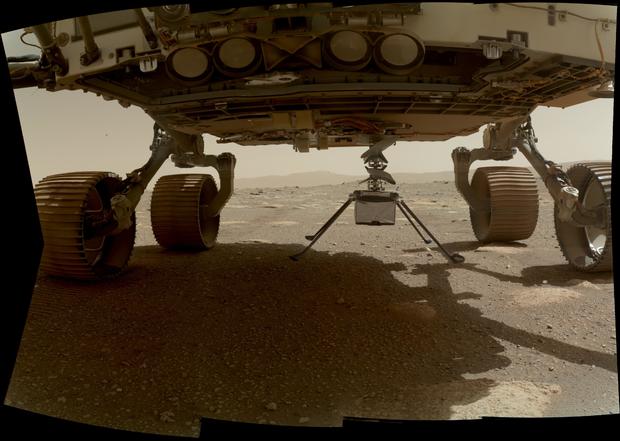NASA's Ingenuity helicopter touches down on surface of Mars ahead of historic flight
NASA is one step closer to achieving the first-ever flight on another planet. Over the weekend, the space agency successfully deployed the Ingenuity helicopter onto the surface of Mars — just days away from its historic takeoff.
NASA confirmed the tiny helicopter's safe delivery onto the Martian surface on Saturday night, marking its successful deployment from the belly of the Perseverance rover, where it's been safely stored.
Scientists were concerned about Ingenuity's ability to survive the frigid Martian night, which reaches temperatures as low as minus-130 degrees Fahrenheit. It's been connected to the rover, using its heater to stay warm — now, it's exposed to the elements.
"No more free power from the rover!" Bob Balaram, Chief Engineer for the Mars Helicopter Project, wrote on Friday.
"The team will check the temperatures and the battery recharge performance over the next couple of days," Balaram said. "If it all looks good, then it's onto the next steps: unlocking the rotor blades, and testing out all the motors and sensors."
A photo taken by Perseverance shows the solar-powered chopper a short distance away from the rover.
Weighing in at just four pounds, Ingenuity's long journey aboard the rover ended with a final drop of 4 inches onto the surface. It's now in position to make history when it attempts flight sometime this month, marking the first powered takeoff and landing on another world.
NASA calls the $80 million helicopter a "high-risk, high-reward" mission.
While scientists have operated plenty of rovers on Mars over the years, Ingenuity will be their first attempt at flight. The first of up to five test flights could come as early as Thursday, depending on winds and weather.
For its first flight, Ingenuity will hover just a few feet from the ground for about 20 to 30 seconds before landing. If successful, the team will then attempt up to four other tests within a month's time frame, each gradually pushing the limits of distance and altitude, like a baby bird learning to fly.
- Everything to know about NASA's Mars Ingenuity helicopter — the first to fly on another planet
- NASA readies Ingenuity Mars helicopter for first flight above the red planet
Flight controllers at JPL won't be able to control Ingenuity while it's actually flying. Due to significant communication delays, commands will be sent in advance of flights, and the team won't know how the flight went until it's over. Ingenuity will be able to make its own decisions about how to fly and keep itself warm.
The helicopter is not equipped with any science instruments and its mission is not part of Perseverance's hunt for signs of ancient life. Rather, it is considered strictly a technology demonstration.
If successful, drones could become standard equipment for future planetary exploration.
In a tribute to aviation accomplishments here on Earth, Ingenuity carries a small piece of fabric from the Wright Flyer, the first aircraft the Wright brothers successfully flew at Kitty Hawk, North Carolina, in 1903.






